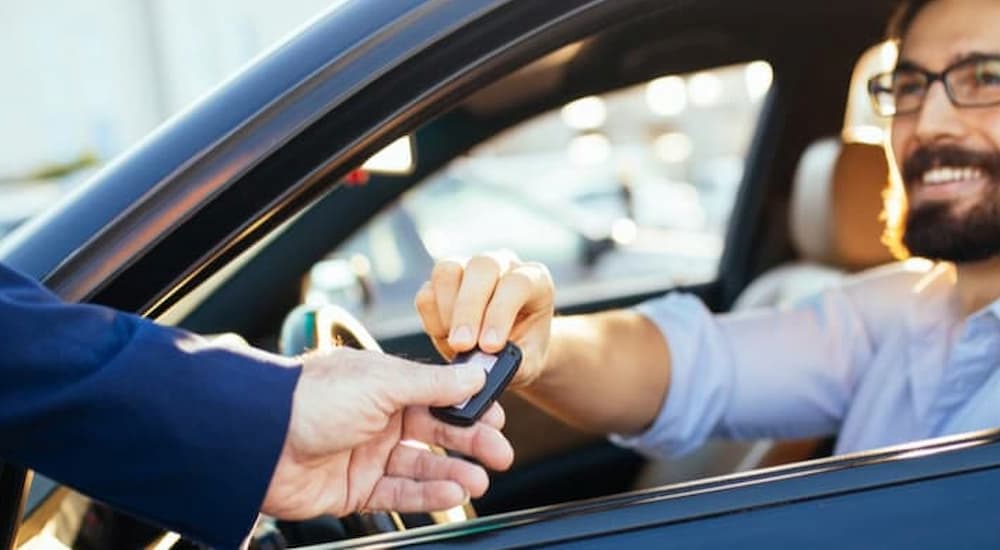As with most things in life, the process of trading in a vehicle and buying or leasing a new one isn’t cut and dry. There are multiple factors to consider, and things like pricing, interest rates, and demand fluctuate regularly. While you can’t rely on information that might change, it’s always good to know your options when you’re ready to value your trade and begin looking for a new vehicle.
Most individuals will choose to trade in their used car, truck, or van and buy another vehicle, which comes with varying interest rates and an acknowledgment of total responsibility. However, if you’re interested in other options, you might want to consider leasing your next vehicle. Are there benefits? What are the downsides? What happens when the lease is up? Read on to learn about the leasing process and how sometimes it is the best decision you can make when it comes to your transportation needs.

Down Payments Are Rarely Required
If you’re looking to trade in your vehicle and purchase a new one, you’ve got to remember to put money aside for the down payment. Many people cannot afford to save up several thousand dollars for a new car, and a lot of times, these same people also do not have top-tier, high-in-demand vehicles, which affects how much they will get for trading it in. Luckily, there is another option: leasing a vehicle. There usually isn’t a down payment required—instead, you’ll pay a security deposit, the first month’s lease payment, and any fees associated with the lease.
You do have the option to use your trade-in as a down payment, which will lower your monthly lease payment amount. What this does for the lessee is reduce the monthly payment price, allow for a higher tier than they may have originally decided on, and provide a better quality vehicle for less money. When you visit your local dealership, it’s a good idea to ask about how their leasing program works. You’ll need information regarding lease terms (how long you will be able to lease the vehicle), payment plans, and whether or not a down payment is, in fact, required by this specific dealership. If they don’t require one, this opens up your options quite a bit, especially if you’ve visited a used car lot or one that regularly takes in fleet vehicles, rental cars, and the like.
You’ll need to do some quick math in your head to see if it’s worth it, but a lot of the time, you will end up paying less on a lease than you would for a vehicle you purchased outright. If you’ve got good credit or a trade-in that is in high demand or is in great shape, it might just be that a leasing option is in your best interest.
You Can Decide Later If You Want to Purchase the Leased Car
If you’re not sure what you’re looking for but you need to buy a commuter straight away, you might get left with everyone else’s leftovers. When you lease, you not only have better options, but you also get to decide after the lease is up whether you want to purchase it or not. It’s up to you, so if it wasn’t to your liking, you can return it to the dealership and lease another vehicle (or buy one if you’re ready to commit). This allows for plenty of time to think, do research, or talk to the family to see what would suit everyone best. This freedom is one of the things that make leasing such an attractive option, especially if you have a growing family and need something with more space or you’re looking for that perfect car for a cross-country road trip.
Leases usually last for two or three years, though there are other term limits that might be a year, or four years, depending on the dealership and your relationship with them. Having a newer vehicle for the next couple of years and then trading up again or moving over to a different kind of vehicle because needs have changed sounds excellent, though some people may want to avoid that hassle altogether and just buy a new car. If you’re open to exploring, trying out something for a while, and taking a bit of extra care with the leased vehicle, then a lease option might work out in your favor. It’s at least worth considering, especially considering the instability of the market and prices that seem to soar with every calendar year.
You Can Just Keep Leasing
When your lease is up, you get to decide how to proceed. Do you want to purchase the vehicle you’ve already been paying on, or are you looking for an upgrade of some kind? Still not sure what car you want? You can bring in your leased vehicle and lease a new one. How does this work? Well, after your lease is up, you can return the vehicle to the dealership, and if you’ve taken care to adhere to the mileage and wear and tear agreements in the lease, and the car is in high demand, you may actually get more trade-in value to use on your next lease. If the vehicle has no damage, you’ve used very little of the mileage allowed, and people are clamoring for it, you’ll more than likely be able to use that as leverage to get the new vehicle you want.
Of course, as previously stated, there aren’t many certain things when it comes to the market, and things will change over time. However, if you’re responsible, have a little luck on your side, and you have a good relationship with the dealership, you may just find yourself driving better and better vehicles because of your track record and sensible business savvy. Take note of what cars remain popular over time and which ones retain their value, and keep that in mind when you’re shopping for a new lease. You won’t regret putting in the time to find what will benefit you most in the long run, whether you’re leasing a popular family vehicle, a sports car with rave reviews, or that instant classic everyone is rushing to the dealership to buy. Knowing what to expect, what to look for, and where to go to get the best deal (and the best pick of the available options) are priceless bits of knowledge.
Before You Buy, Look at Your Leasing Options
Next time you’re in the market for a vehicle, be sure to go over all your options. If there’s a newer model you’ve been eyeing or some premium features you’d like to try, but you don’t have enough trade-in value to make it work, consider taking the route of a lease. Even if you ultimately decide that you’re better off buying, knowing that you can lease a vehicle down the road can be something to look forward to. And, of course, if you do end up leasing, you’ll be paying less for something a bit fancier if you’re interested in that sort of thing. Many individuals have found it more cost-effective to lease a vehicle now and switch it out for something else in a few years, never having to worry about keeping it running until it gives up the ghost. So, when the time comes to trade-in your vehicle, consider leasing your next one.





